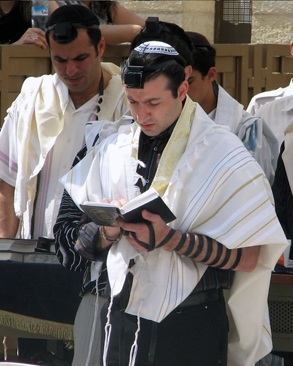
This word appears only once in the Bible; in condemning the hypocrisy of the teachers of the law and the Pharisees, Jesus accused them of making "their phylacteries wide and the tassels on their garments long" (Matt 23:5).
A phylactery consists of two small boxes, made from the leather of clean animals, with straps attached to them. One is attached to the forehead, and the other to the left hand of Jewish men when they pray. Each of the boxes contains parchments on which are inscribed four passages of Scriptures: Exo 13:1-10; 13:11-16; Deut 6:4-9, and 11:13-21. The basis of the practice is found in a literal understanding of the four passages that "this observance will be for you like a sign on your hand and a reminder on your forehead that the law of the Lord is to be on your lips" and "these commandments that I give you today . . . tie them as symbols on your hands and bind them on your foreheads."

Jews in prayers with phylacteries
at the Western Wall, Jerusalem.
The English word is a transliteration of the Greek phylakterion, "a means of protection," i.e., "an amulet." Since most Jews who use phylacteries do not think supestitiously of them, the name, it is believed, probably derived from a non-Jewish source who thought of them as amulets. Jews call them tepilla, "prayer."
It is easy for Christians to fall into cynicism when they view Jews using their phylacteries, even quoting Jesus to support their cynicism. What Jesus was condemning was not the use of phylacteries but their ostentacious show of piety in "making their phylacteries wide and the tassels on their garments long." The meditation that actually accompany the putting on of the prayer shawl and the care in attaching the phylacteries remind them of the seriousness of coming reverently before God when they come in prayer. It is an attitude that is sadly missing far too frequently in Christian prayers.

©ALBERITH